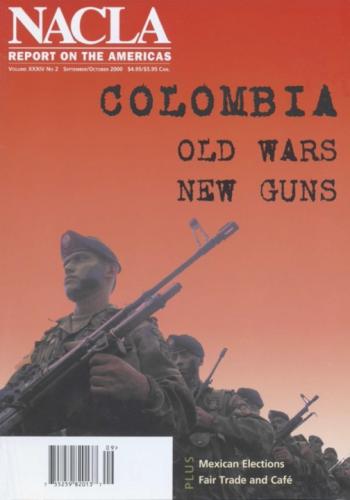Report
In January 1999, newly elected Colombian president Andrés Pastrana ceded an area of southern Colombia the size of Switzerland to the Revolutionary Armed Forces of Colombia (FARC) guerrillas as part of an agreement to begin peace talks.
The sky above the Barrio Nelson Mandela on a recent afternoon is a whirl of blue and black dots: blue from the makeshift kites that the neighborhood children improvise from plastic bags, black from the buzzards that circle over the nearby city garbage dump.
An experimental fungus to be sprayed in Colombia might damage not just drug crops, but the biosphere and humans as well. Between 1992 and 1998, about 660,000 gallons of the herbicide glyphosate were sprayed in Colombia to eradicate more than 46,000 acres of opium poppy fields and 101,000 acres of coca.
Peace? What peace? As far as most Colombians are concerned, the peace process is going nowhere fast. "Do you approve of the government's policies towards the guerrillas?"
This interview with a young Colombian soldier was conducted in the Barrancabermeja area in late 1999. For reasons of personal safety, the interviewer, a reputable Colombian war journalist, has requested anonymity.
Sip a steaming brew at Starbucks, and you might associate coffee with prosperity. The image of carefree consumers enjoying $3 lattés seems totally unrelated to that of coffee-bean farmers and workers, who live with unrelenting poverty, illiteracy and a long legacy of economic colonialism.
On January 11 of this year, President Clinton pleaded for "emergency spending" for Colombia. But "emergency" seemed a misnomer, since drug production and trafficking—conveniently conflated with a chronic civil war—have been happening in Colombia for decades.
On June 24, 1988 Texas oilman Jake Gambini was kidnapped in Colombia by a group of guerrillas. For the next six months—during which time the guerrillas never revealed what political group they belonged to—Gambini's employees and his Colombian brother-in-law, Herbert "Tico" Braun, would engage in protracted ransom bargaining.
Fierce battles, often characterized by extreme cruelty, marked the early twentieth century in Colombia, as land-hungry peasants and their reformist allies faced off against the country's land-owning oligarchy, which was backed by the conservative hierarchy of the Catholic Church. The land owners and Church leaders, along with peasants under their control, were organized as the Conservative Party; other, reform-minded peasants and their allies were known as Liberals.
When international attention is directed to the Colombian peace process, most observers focus on government dealings with the Revolutionary Armed Forces of Colombia (FARC). A unique meeting in Switzerland on July 24 and 25, however, revealed the possibilities and difficulties of a very different kind of process: one carried out with the National Liberation Army (ELN), Colombia's second major guerrilla group.
In November 1981, the April 19th Movement (M-19) guerrilla group kidnapped and demanded ransom for Martha Nieves Ochoa, a member of the prominent Ochoa drug trafficking clan, who were members of the then-powerful Medellín Cartel.[1] The next month, with Martha still a hostage, her family called a meeting in Medellín to discuss the situation.

